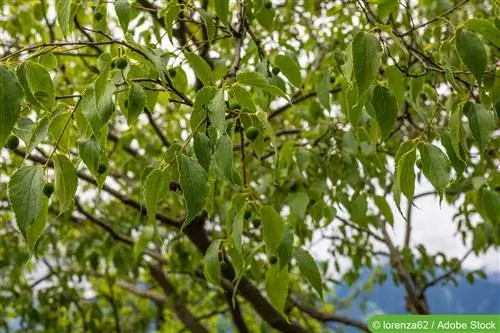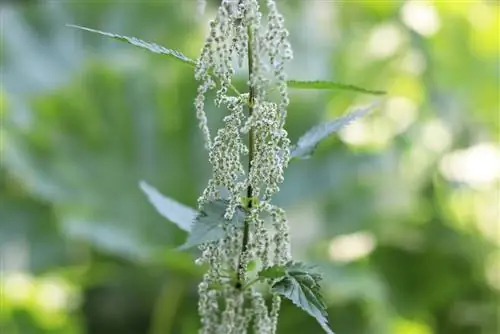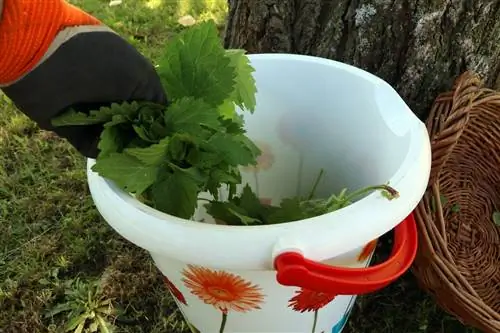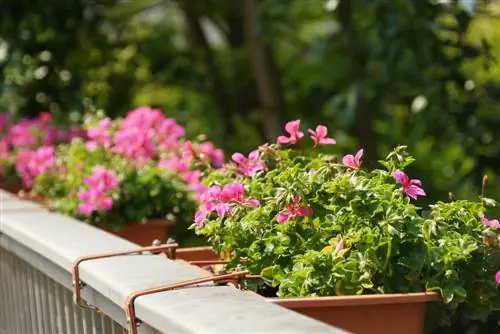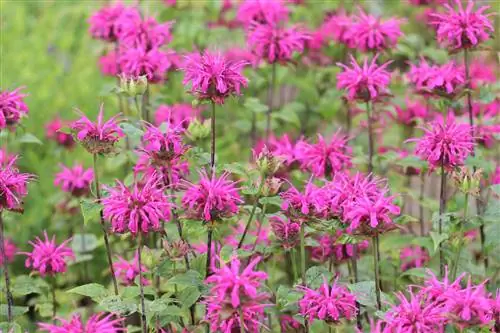- Author admin [email protected].
- Public 2023-12-17 03:39.
- Last modified 2025-01-24 12:45.
The hackberry tree is the ideal tree for conservationists. The plant, which can reach a height of up to 20 meters and lives for several hundred years, provides an interesting environment for many native insect species with its foliage and yellow flowers. The spherical, dark stone fruits are often eaten by local bird species such as thrushes, starlings, blackbirds, waxwings and bullfinches and the hackberry tree also does a lot to improve air quality.
Location
The hackberry tree needs a bright and sunny location and appreciates direct sunlight even in spring. The location can also be chosen so that the tree is in partial shade in summer, because the tree is also happy with these conditions. The hackberry tree likes warmth and can cope with heat and occasional drought. The deep-rooted plant likes stony and well-drained soils that are rich in lime and poor in nutrients. Overall, it is undemanding and grows well in any garden that has permeable soil. It should be borne in mind that due to its growth it is the perfect plant for larger gardens and parks. The ideal location:
- offers sun and brightness
- has permeable, stony and well-drained soil
- should be large in order to offer the tree optimal development
- is rich in limestone and often low in nutrients
Planting/Repotting
In the pot, the hackberry tree should be repotted every two to three years. Repotting should then be combined with intensive root pruning to inhibit growth.
Substrate & Soil
The quality of the soil or the substrate is less important for the hackberry tree because it is undemanding. Calcareous and nutrient-poor soils are not a problem. The only condition that the tree imposes is that the soil must be permeable to water and not cause waterlogging. The substrate may be neutral to slightly alkaline. The hackberry tree
- does not require any special substrate
- tolerates calcareous and nutrient-poor soils
- needs a water-permeable soil
- appreciates a neutral to slightly alkaline substrate
Fertilize
Fertilizing the hackberry tree should begin in spring when the tree sprouts its first leaves. A liquid fertilizer applied to moist soil is ideal. The tree is then supplied with liquid fertilizer every two weeks when it is young. Fertilization with organic fertilizer cones as a long-term fertilizer can also be very interesting. Towards autumn, around the end of August, the last fertilization for the year should be carried out with a high-potash fertilizer, which will help the tree harden against winter. The organically matured fertilizer is incorporated into the entire soil around the tree. You should fertilize
- in the spring before the first leaves emerge for the first time
- with liquid fertilizer
- For young trees, preferably every two weeks
- to strengthen the tree in hardening against winter and fungal attack
Pouring
The hackberry tree tolerates heat very well, but has a high water requirement in hot weather, especially in windy locations. Regular watering is important now. The leaves of the tree can also be moistened with water every day. However, you should always avoid waterlogging when watering. In general, the roots should never dry out completely. During rainy periods, the tree supplies itself with sufficient fluid.
Cutting
The removal of older branches of the hackberry tree should be done in the cold season because then there is only reduced blood flow to the branches. If there are major injuries caused by the cut, it makes sense to cover it with tree wax. When new growth occurs in spring, the shoots should be allowed to grow to about 15 cm wide and then cut back to one or two leaves. This results in intensive branching right into the tips of young trees. This procedure should be carried out on a young tree over an entire summer. The tree can be shaped by wiring or a targeted cut. Tension wire can support the perfection of the tree parallel to the cut and correct the growth as desired. Anyone who wires the tree in addition to cutting should ensure that the branches are protected from injuries and that the wire does not grow in. This can be prevented by wrapping it with wheel diabast.
Propagate
The propagation of the hackberry tree is relatively easy and does not require a green thumb. For propagation, the fruits are collected in autumn and the seeds are removed. The seeds are then simply placed in appropriate plant pots with potting soil. For germination, the pots should then be placed in a protected place where they receive sufficient light and are of course regularly supplied with water without waterlogging forming. Young plants need to be protected from frost, especially in the first two years, and are therefore only left outdoors on really warm days.
Wintering
However, a general distinction is made between the southern hackberry tree, also known as Celtis australis, or the western hackberry tree, known as Celitus iccidentales. The first is very sensitive to frost, especially in its youth, and especially in the first two years, and needs protection, especially since it usually retains its leaves. The western hackberry tree, on the other hand, usually sheds its leaves and is completely hardy from the third year onwards and only needs frost protection as a young plant. A winter temperature of between 5 °C and 15 °C not only protects the plant, but also makes it more robust against pest infestation for the next season. When overwintering
- A distinction is made between the western and the southern hackberry tree
- temperatures should be between 5 °C and a maximum of 15 C
- The Western tree only needs protection in the first two years
Pests/Diseases
The hackberry tree is relatively often attacked by spider mites. This leads to unexpected and, above all, premature shedding of leaves. The only way to combat spider mites is to use chemical insecticides that are commercially available. It is particularly important for the frost-sensitive variety and young plants that they receive absolute frost protection in winter. The ideal protection against pest infestation is if they are overwintered at temperatures between 5 °C and 15 °C, because then they become more robust against infestation. The wintering temperature shouldn't be any warmer.
Frequently asked questions
Can I use the fruits of the hackberry tree?
The hackberry tree produces fruits similar to cherries, although they are more floury in consistency and also contain a relatively large stone. Even though the fruits taste pleasantly sweet when they are ripe and purple-brown to black, they are less suitable for raw consumption and more suitable for further processing, for example into jam. The fruits, which are known as zürgeln, can also be processed as a stand-up. The fruits can of course also be made into liqueur.
Why is the hackberry tree the perfect tree for the city?
The hackberry tree is the ideal city tree because it has amazing properties when it comes to air purification. A single fully grown hackberry tree is able to convert 145 kg of CO2 into oxygen within a year and filter around a ton of dust from the air, which is why it can provide an enormous improvement in air quality, especially in metropolitan areas.
What you should know about the hackberry tree in brief
The hackberry tree that grows here is the European hackberry tree (Celtis australis), often simply called the hackberry tree, although the genus of hackberry trees includes several dozen species. It used to be classified as part of the elm family. However, according to recent findings, it belongs to the hemp family. The hackberry tree was also called the nettle tree in our country, e.g. B. in an economic encyclopedia from 1773, in which the main name of this beautiful tree is still given as the lotus tree.
- The European hackberry tree has its natural home in southern and southeastern Europe from France via Austria to Romania.
- The typical southern European avenue tree has spread from there in several directions.
- It is currently hardly known here, although it thrives without any effort, especially in the southern part of Germany.
- It used to be planted as an ornamental tree in numerous southern German parks, and there were also magnificent hackberry tree avenues to admire.
Due to a superficial similarity, the European hackberry tree is sometimes confused with the much more common mulberry tree, which is therefore usually not considered worthy of protection, which has led to the decimation of some rare specimens: Since experts are also subject to this misjudgment, e.g. For example, in 2003, a 25-year-old avenue of hackberry trees was felled in a town in the Palatinate, which experts described as unique in Germany.
- Hackberry trees can be up to 20 meters high and several hundred years old.
- The yellow flowers, which appear in May at the same time as the leaves, are interesting for a wide variety of local insects.
- Later in the year they develop spherical dark drupes with stalks, from which many other native bird species live.
- The deep-rooted plant develops strong roots that give it good grip even on rocky ground.
Buy hackberry trees
- Hackberry trees are now available again in some tree nurseries, e.g. B. from the New Garden tree nursery in 46325 Borken-Weseke, can be ordered at www.baumschule-newgarden.de. The tree with a trunk circumference of 8 to 10 cm costs 70 euros.
- If you want to approach the hackberry tree more carefully, you can get a very small hackberry tree, 30 to 50 cm for 6 euros, which can be ordered from Plantmich GmbH from 22763 Hamburg at www.pflanzenmich.de.
Edible fruits
The fruits of the hackberry tree are also edible for humans, they resemble cherries and are ripe when they are purple-brown to black. The fruits taste pleasantly sweet, but have a fairly large stone. They are also much flourier than cherries, which is why jam was mainly made from them. Also interesting should be a set-up that you could make from your pineapples (that's what the stone fruits are called) and clear schnapps.

